Goldfish plants are easy to care for and fun to grow. The lush foliage and bright blooms make them an eye-catching addition to any houseplant collection.
But to fully enjoy their beauty you’ll first need to learn how to care for goldfish plants properly.
This guide is designed to help beginners learn all about goldfish plant care. From water, light, fertilizer, and soil to pruning, propagation, pest control, and more, everything you need is right here.
Goldfish Plant Quick Care Overview
| Scientific name: | Nematanthus gregarius |
| Classification: | Tropical plant |
| Common names: | Goldfish Plant, Guppy Plant |
| Hardiness: | Zones 10-12 |
| Temperature: | 60-75°F (15.5-23.8°C) |
| Flowers: | Red, orange, yellow, spring-summer |
| Light: | Light shade, bright, indirect light indoors |
| Water: | Keep moist, allow to dry slightly between watering |
| Humidity: | Average to high |
| Fertilizer: | High phosphorus liquid or granules, spring-summer |
| Soil: | Loose, coarse, well-draining |
| Common pests: | Aphids, scale, spider mites, mealybugs |
Information About Goldfish Plant
Goldfish plants (Nematanthus gregarious) are tropical perennial epiphytes native to Central and South America.
They grow naturally in trees or on rocks, and absorb moisture and nutrients from the air and surroundings through the thick, waxy green foliage and shallow roots.
Its common names, goldfish or guppy plant, come from the bright orange, yellow, or red tubular flowers that resemble a leaping goldfish.
The branches naturally trail or drape, and average about 3’ in length with 2-3” leaves and small flowers, which are usually only about a 1/2″ long.
Goldfish Plant Varieties
There are many types of goldfish plants that offer different hues on both the foliage and flowers. No matter which type you get, they all need the same general care to thrive.
- Firebird – This variety offers a striking contrast of dark green leaves and vivid red blooms.
- California Gold – Yellow flowers with red margins are a loved characteristic of this variety.
- Chanticleer – This type of guppy plant is known for compact growth and abundant blooms.
- Tropicana – This variety features red and orange striped flowers and deep green foliage.
Flowers
The arched, tubular flowers give the goldfish plant its name because when they bloom they look like fish jumping out of the water.
They require a lot of light and a consistent environment to bloom, but it’s worth the reward.
You can look for the blossoms to appear in spring and summer in red, yellow, orange, or a combination of those colors.
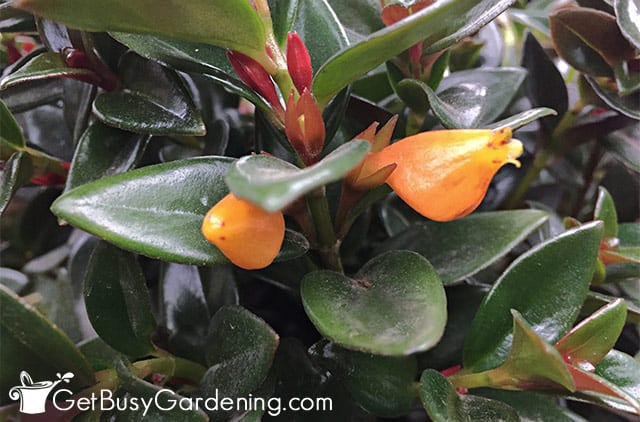
Toxicity
According to the ASPCA website, the goldfish plant is non-toxic to both dogs and cats. So it’s a great indoor plant to have near your pets.
How To Take Care Of Goldfish Plant
Before we chat about how to care for a goldfish plant, first let’s talk about the best location to grow it. Picking the right spot is important to ensure it can thrive.
Hardiness
The goldfish plant doesn’t tolerate heat or cold, and can only grow outdoors year around in zones 10-12.
Even in warm regions, they have to be kept out of the extreme heat and hot direct sunlight.
In most areas, they’re better kept indoors as houseplants where they can enjoy a consistent temperature and controlled light exposure.
Where To Grow Goldfish Plant
The best location to grow Nematanthus gregarius is somewhere with plenty of bright light that’s out of the direct sun.
Avoid places near drafts, cold windows, or vents. Dry, hot, or cold airflow can easily stress out your guppy plant.
The trailing growth is popular in hanging pots, but any container that has proper drainage will do.
If growing outdoors, wait until it’s above 60°F (15.5°C) at night to move it outside. Choose a shaded location, and move it back inside before temps hit 80°F (26.7°C) or above.
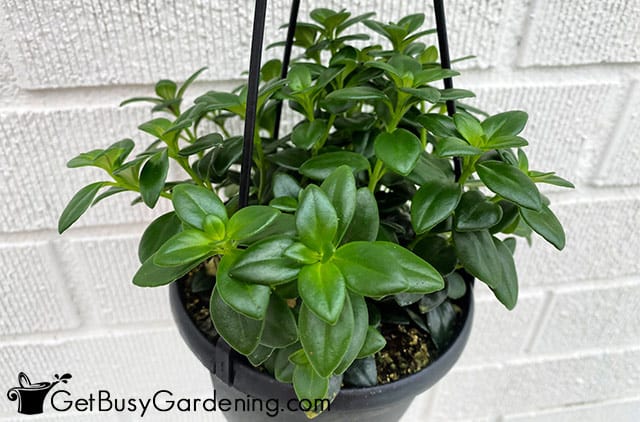
Goldfish Plant Care & Growing Instructions
Now that you have the ideal location in mind, let’s talk about how to provide the best goldfish plant care. Use these tips to create the perfect environment.
Light
A goldfish plant requires lots of bright, indirect light to grow and bloom. Outdoors they can handle some sun in the early morning or late evening.
Avoid direct afternoon or intense sunlight, which can burn the leaves, but choose a spot that will get at least 9 hours of indirect light per day.
Indoors you can place them near a sunny window or in a bright room. If you have trouble providing enough, add a grow light to supplement.
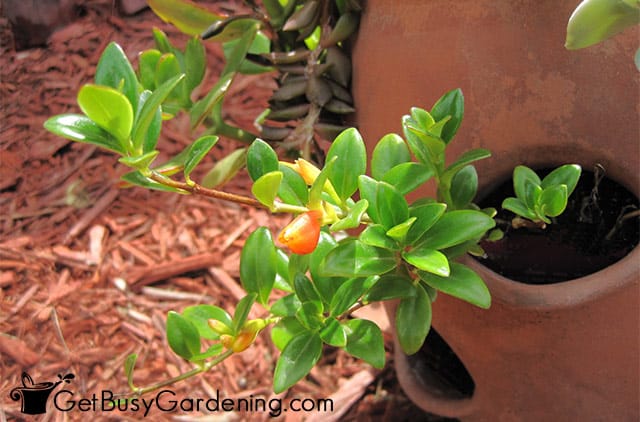
Water
Guppy plants don’t like to dry out for long, but also won’t tolerate wet feet. The waxy leaves store water, so wait for the soil to dry out 2” deep before giving it more.
The goal is moist, but not soggy, soil. Check it with a moisture gauge to help keep it at the right level.
Use only room temperature water because the cold can shock it, and always drain any excess away.
It’s also best to use distilled or rainwater to avoid salt and chemical buildup in the soil from tap water, which can harm your plant.
Humidity
Humidity is a very important part of goldfish plant care because they’re epiphytes. In their native tropical environment, they would absorb moisture from the air.
A humidity monitor is a good way to check the levels in your home. They can tolerate down to 50% humidity, but will thrive with higher levels.
A small humidifier, pebble tray, or daily light misting are all good options for increasing it.
Temperature
Goldfish plants are very particular and finicky about temperature, so take extra care to get this right.
They prefer a range between 60-75°F (15.5-23.8°C). Anything higher than that and they can experience leaf drop and browning.
Colder temperatures can cause the flowers, buds, and leaves to drop, and will eventually kill the plant.
Sudden fluctuations between the two extremes can also stress and damage the plant. So keep them away from heating vents, air conditioning, and drafty, hot, or cold windows.
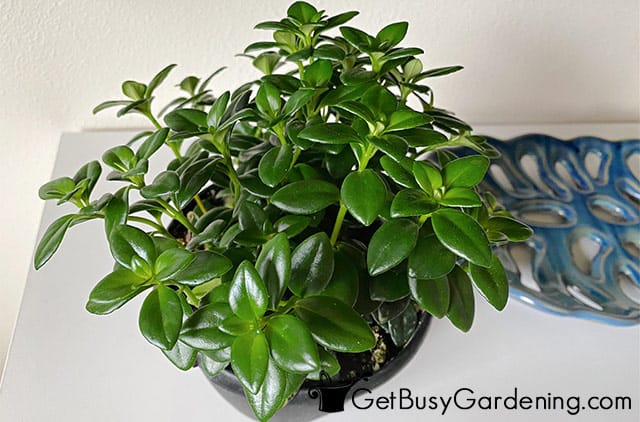
Fertilizer
Feeding your goldfish plant through the spring and summer is a great way to encourage healthy growth and flowering.
Use an organic liquid fertilizer, compost tea, or fish emulsion diluted to half strength every 2 weeks, or apply slow-release granules once a month.
A high phosphorus option designed for flowering plants is also a good choice to encourage additional blooms.
Do not use synthetic chemical fertilizers because they can build up in the soil and cause harm to your plant over time.
Soil
Epiphytic guppy plants don’t technically need soil to grow since they’re often natively found attached to tree trunks and rocks. But they can grow well in a coarse, loose, well-draining mix.
Cactus soil or an African violet potting mix are good options, or you can amend a quality, general purpose potting soil with perlite or pumice to improve drainage.
A soilless mixture of sphagnum or peat moss, perlite, and vermiculite is also a good combination.
Repotting
Goldfish plants have shallow roots and prefer to be pot-bound, so they should only need repotting every 2-3 years, or when the roots are very compacted.
Repot in the spring before flowering, and move them up no more than 1 pot size. Too much room can cause legginess or overwatering.
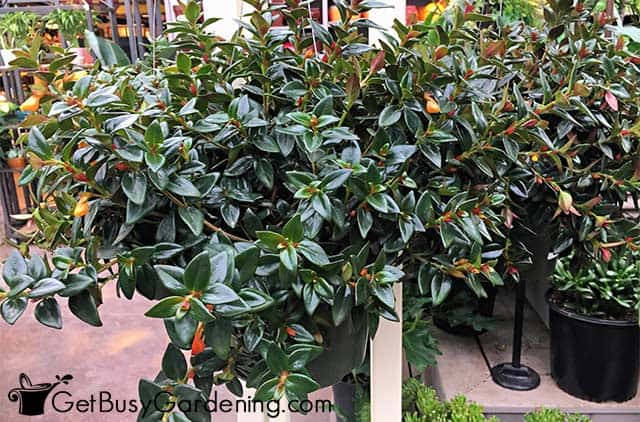
Pruning
Regular pruning as a part of your goldfish plant care routine is a great way to encourage bushier growth.
Use sharp, sterile precision pruners or micro-snips to cut back branches in early spring when new growth appears. You can also pinch back tips after flowering.
Pest Control Tips
Pests like mealybugs, spider mites, and thrips can become issues for Nematanthus gregarius.
Treat your plant at the first sign of bugs with an organic option, like insecticidal soap or neem oil. You can make your own by combining 1 teaspoon of mild liquid soap with 1 liter of water.
Apply rubbing alcohol to any visible bugs with a cotton swab as well to start controlling them immediately.

Goldfish Plant Propagation Tips
Goldfish plants can be propagated by cuttings in either spring or fall. Use clean precision pruners to clip healthy, flowerless stems that have leaves attached.
Remove the lower leaves leaving a 2-3 inch stem, and dip the cut end in rooting hormone. Then place it in damp, fast-draining soil. Keep it moist in indirect light until you see new growth, then pot it up.

Troubleshooting Common Goldfish Plant Problems
Goldfish plants are known for being temperamental, but with the proper care anyone can grow one. If you encounter one of these more common issues, use my tips to get it back in good health.
Dropping Leaves
Leaf drop can be caused by a variety of environmental factors, like drafts, dry air, cold temperatures, and overwatering.
Keep the environment as consistent as possible by removing fluctuations from air vents, heaters, and open windows.
Use a moisture gauge to make sure you’re keeping it watered at the perfect level.
Goldfish Plant Leggy
Legginess on your goldfish plant is usually caused by low light or too large of a container.
They and need at least 9 hours of bright light a day. If the room is too dark, try using a grow light.
They prefer to be root-bound, and regular pruning and pinching will also help to keep yours bushy.
Leaves Turning Yellow
When leaves begin to yellow it’s a sign of overwatering, too much light, a nutrient deficiency, or a build up of salt in the soil.
Never water the point where the soil becomes soggy or allow it to sit in water. Keep it away from direct sun, and try adding an organic fertilizer to give it a boost of nutrients.
If the container has a build-up of salt from tap water or chemical fertilizer, switch to distilled or rainwater and use organic plant food.
Brown Leaves
Browning leaves on Nematanthus gregarius is most commonly caused by high heat, dehydration, or direct sunlight.
Keep it at temps below 80°F (26.6°C), make sure the soil stays moist, and give it more shade.
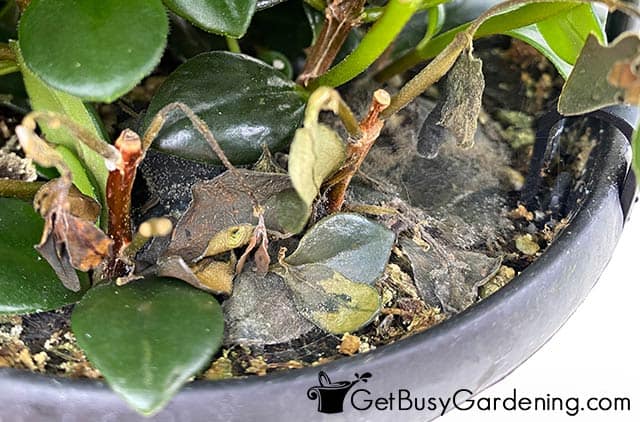
FAQs
Here I’ve answered some of the more commonly asked questions about goldfish plant care. If yours isn’t listed, please add it to the comments section below.
Is a goldfish plant toxic?
No, a goldfish plant is non-toxic to people and pets according to the ASPCA website, so it is safe to have around your cats and dogs.
Is goldfish plant annual or perennial?
A goldfish plant is a perennial in zones 10-12, though it’s most commonly grown as a houseplants. It will thrive and bloom for many years given the proper care and the right environment.
Are goldfish plants easy to care for?
Goldfish plants are not always very easy to care for because they are picky about temperature, light, humidity, and water. Once you master creating the ideal environment however, they can be a beautiful thriving addition to your home.
How long do goldfish plants last?
Goldfish plants are perennials that can last for many years with the proper care, especially when kept indoors in the ideal environment.
Is goldfish plant indoor or outdoor?
A goldfish plant can be grown indoors or outdoors, but many gardeners choose to have them as houseplants because they are sensitive to temperature changes, water, wind, and sunlight.
What is a guppy plant?
A guppy plant is another common name for Nematanthus gregarius, also called the goldfish plant.
If you want to learn all there is to know about maintaining healthy indoor plants, then you need my Houseplant Care eBook. It will show you everything you need to know about how to keep every plant in your home thriving. Download your copy now!
More Houseplant Care Guides
- How To Care For Black Pagoda Lipstick Plant
- How To Care For A Lipstick Plant (Aeschynanthus radicans)
- How To Care For African Mask Plants
- How To Care For Ric Rac Cactus (Epiphyllum anguliger)
Share your goldfish plant care tips in the comments section below.

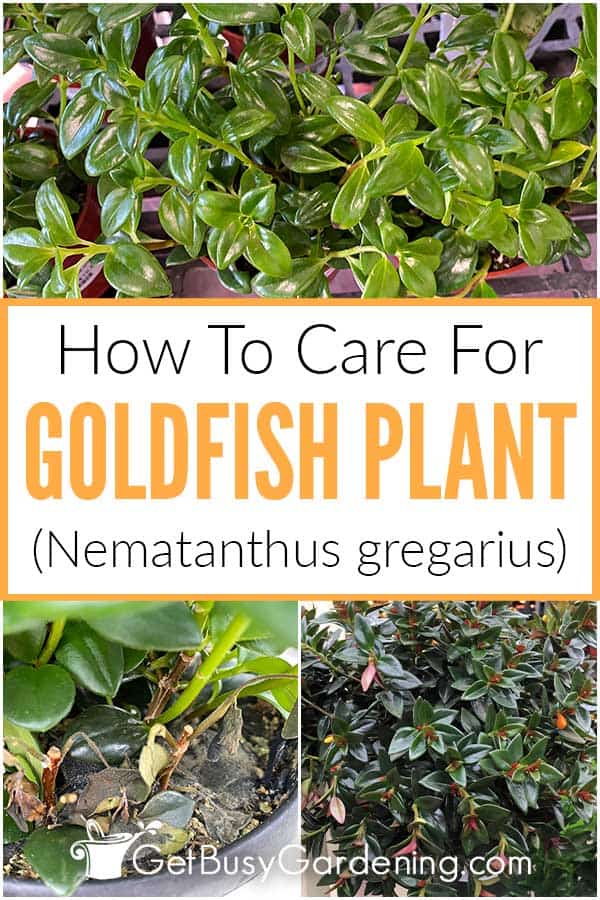
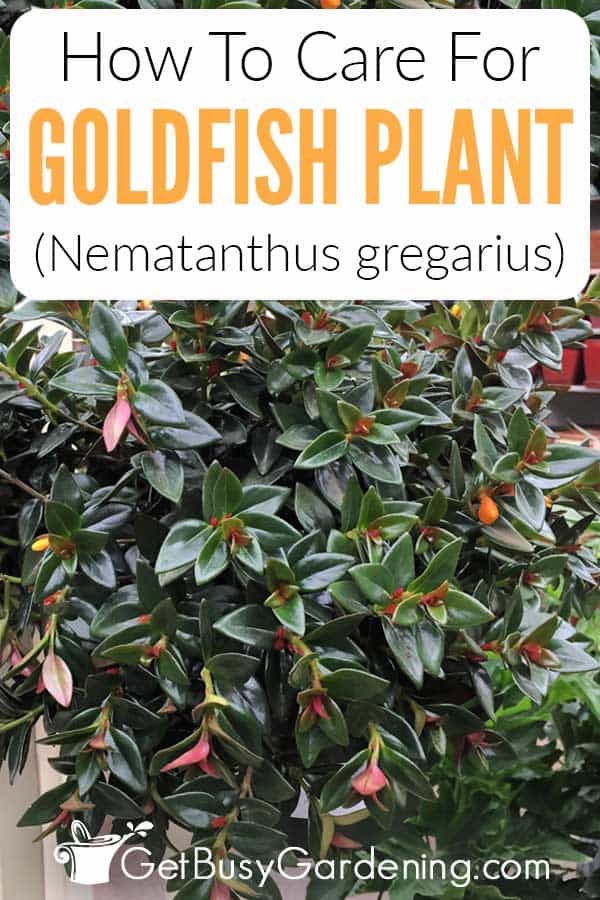
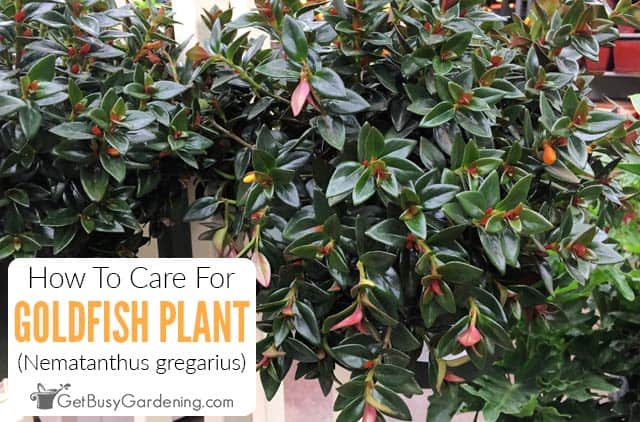





Leave a Reply